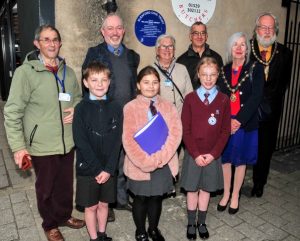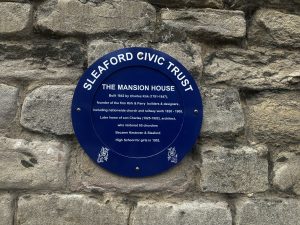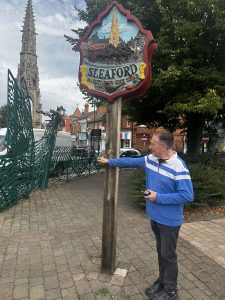


The original Committee decision and aspiration was to place plaques showing historical information on our town bridges, but after some discussion we came up with the idea of also providing blue plaques for notable people who were born in or have been associated with Sleaford and who have made their mark on the town.
With this in mind, and to move on with the Project, we formed a Working Group from four of our Committee Members and also Dr Simon Pawley. At our first meeting, a priority list of the bridges and also the people to be commemorated on the first few plaques we would like to be installed was drawn up. We then met up with the Conservation Officer at North Kesteven District Council, who agreed to have a town walkabout with the members of the Working Group. His knowledge and advice on the best siting for each bridge and relevant building plaque proved to be of great help and I am sure will continue to be invaluable to enable the future implementation of the Project.
Following on from our walkabout, both Simon and John Dale (our Committee colleague and Civic Trust Researcher) produced some appropriate wording for each plaque and a manufacturer was found to produce the appropriate style of plaque for us at a realistic price. We then need to obtain permission from the relevant building owners for installation of a plaque on their property.
On 14th August 2024, we celebrated with great pride as the first two plaques were erected. You may have noticed that the photograph in the centre above is actually a cake!
John Dale unveiled the first blue plaque at the entrance to Ward and Dale's former yard and workshops at what is now the New Life Church, Mareham Lane. Ward and Dale were the world's largest steam ploughing company, and John Dale is the great grandson of its founder. The beautiful cake helped to celebrate the occasion in a light lunch for Civic Trust members and invited guests.
The second plaque was unveiled by Dr Simon Pawley on the railings above the Nine Foot river bridge next to Riverside Church and is the first of the blue plaques to name bridges in the town.
So watch this space as we hope to give more information of each Plaque as it is placed - two more are planned for later in the year. John also intends to produce a ring binder file containing the plaque details which you will be able to view in Sleaford Museum.
This is an exciting and ongoing project for the Civic Trust. We pride ourselves that we are not only commemorating some of the people who have made their mark on our town, but we are also helping to make residents and visitors alike aware of some of the town history.









Historic Town Signs
The original wooden town signs which were placed on the entry roads into Sleaford were replaced several years ago. Civic Trust member and local artist, Harriott Brand, offered her skills to renovate and paint the historic town signs to be erected into the refurbished Monument gardens outside Sleaford Museum.
The signs were unveiled at the Grand Re-opening of the gardens on November 16th 2024.



